Koichi Wakata
Koichi Wakata (若田 光一, Wakata Kōichi, born 1 August 1963) is a Japanese engineer and a JAXA astronaut. Wakata is a veteran of four NASA Space Shuttle missions, a Russian Soyuz mission, and a long-duration stay on the International Space Station.[1] During a nearly two-decade career in spaceflight, he has logged more than eleven months in space. During Expedition 39, he became the first Japanese commander of the International Space Station. Wakata flew on the Soyuz TMA-11M/Expedition 38/Expedition 39 long duration spaceflight from 7 November 2013 to 13 May 2014. During this spaceflight he was accompanied by Kirobo, the first humanoid robot astronaut.[2]
Koichi Wakata | |
|---|---|
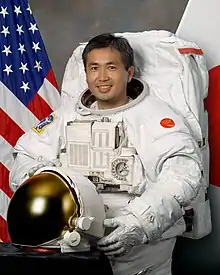 | |
| Born | 1 August 1963 |
| Status | Active |
| Nationality | Japanese |
| Occupation | Structural Engineer |
| Space career | |
| NASDA/JAXA Astronaut | |
Time in space | 347 days, 08 hours, 32 minutes |
| Selection | 1992 NASDA Group |
| Missions | STS-72, STS-92, STS-119/127 (Expedition 18/19/20), Soyuz TMA-11M (Expedition 38/39) |
Mission insignia | 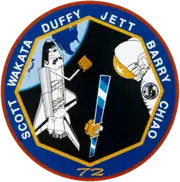 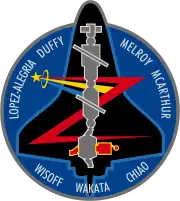 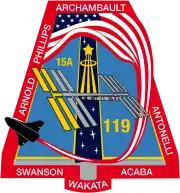 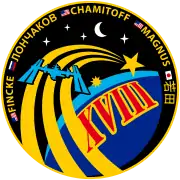 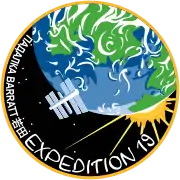 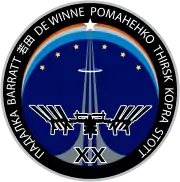 |
Career
Wakata was born in Ōmiya, Saitama, Japan, earned a Bachelor of Science degree in Aeronautical Engineering in 1987, a Master of Science degree in Applied Mechanics in 1989, and a Doctorate in Aerospace Engineering in 2004 from Kyushu University.[1] He worked as a structural engineer for Japan Airlines.
JAXA career
Wakata was selected by the National Space Development Agency of Japan (NASDA) (now JAXA) as an astronaut candidate in 1992, and trained at NASA's Johnson Space Center. Wakata has held a number of assignments, and during STS-85, Wakata acted as NASDA Assistant Payload Operations Director for the Manipulator Flight Demonstration, a robotic arm experiment for the Japanese Experiment Module of the International Space Station (ISS).[1] In December 2000, he became a NASA robotics instructor astronaut. In July 2006, he served as commander of the 10th NASA Extreme Environment Mission Operations (NEEMO) mission, a seven-day undersea expedition at the National Oceanic and Atmospheric Administration’s Aquarius laboratory located off the coast of Florida.[1] In August 2006, he started flight engineer training for Russian Soyuz spacecraft in preparation for a long-duration stay on the ISS.[1]
Spaceflight experience
Wakata first flew aboard STS-72 in 1996, and then returned to space on STS-92 in 2000.[1] Wakata was stationed at the International Space Station (ISS) and returned to earth aboard Endeavour with the STS-127 crew on July 31, 2009. On Nov 7, 2013 Wataka returned to the ISS aboard Soyuz TMA-11M for a 6-month mission covering Expeditions 38 and 39. He became the ISS commander for the last two months of that mission on Expedition 39.[3]
STS-72
On STS-72, Wakata became the first Japanese Mission Specialist.[1] STS-72 retrieved the Space Flyer Unit (launched from Japan ten months earlier), deployed and retrieved the OAST-Flyer, and evaluated techniques to be used in the assembly of the International Space Station.[1]
During STS-72, Wakata and fellow astronaut Dan Barry became the first people to play the game Go in space. Wakata and Barry used a special Go set, which was named Go Space, designed by Wai-Cheung Willson Chow.[4]
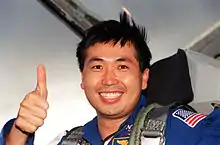
STS-92
Wakata became the first Japanese astronaut to work on the assembly of the International Space Station during STS-92. The crew attached the Z1 truss and Pressurized Mating Adapter (PMA3) to the station using Discovery’s robotic arm. STS-92 prepared the station for its first resident crew.[1]
Expedition 18/19/20
In February 2007, Wakata was assigned as a flight engineer to ISS Expedition 18, scheduled to begin in winter of 2008.[5] He launched with the crew of STS-119 and was the first resident station crew member from the Japanese Aerospace Exploration Agency (JAXA).[5] He served as Flight Engineer 2 on Expedition 18, Expedition 19 and Expedition 20, before returning home as a Mission Specialist on STS-127.
Wakata was the first Japanese astronaut to take part in a long-duration mission on the station.[1]
Wakata is the first person to serve on five different crews without returning to Earth: STS-119, Expedition 18, Expedition 19, Expedition 20 and STS-127.[6]
During his time on the station, he took part in experiments suggested by the public, including flying a "magic carpet", folding laundry and doing pushups.[7]
As an experiment on the station, he wore the same special underpants for a month without washing them.[8] Wakata returned to Earth in July 2009 aboard Endeavour with the STS-127 crew after being a flight engineer on the station. American and Canadian astronauts aboard STS-127 delivered and installed the final two components of the Japanese Experiment Module: the Exposed Facility (JEM-EF), and the Exposed Section (JEM-ES).
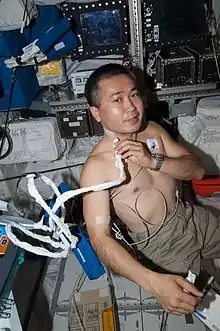
Expedition 38/39
Wakata launched on Soyuz TMA-11M to the International Space Station in November 2013. During Expedition 38 and Expedition 39, Kirobo—who had the mission to serve as a companion robot to the astronaut[9]—worked closely with Wakata, conducting experiments in space through verbal orders from the astronaut. One of the experiments was the first-ever human-robot conversation in space.[10][11] Wakata arrived on the International Space Station as part of Expedition 38 in late 2013. He became the commander of the International Space Station with Expedition 39, in March 2014. This marked the first time a Japanese astronaut became ISS station commander, and only the third time an astronaut of neither Russian nor American citizenship served as station commander.[12] Wakata returned to Earth on May 13, 2014.
Fifth flight
Wakata trained as backup for JAXA astronaut and SpaceX Crew-1 mission specialist Soichi Noguchi ahead of his long duration stay aboard of the ISS as part of Expedition 64.[13] Shortly after Noguchi's launch in November 2020, JAXA announced that Wakata would return to the ISS for another long duration mission in 2022[14]
Honors and Awards
Minor planet 6208 Wakata is named after him.[15]
Personal information
Wakata is married to Stefanie von Sachsen-Altenburg of Bonn, Germany, and has an twenty-two-year-old son.[1][16][17] He is a multi-engine and instrument-rated pilot, and has logged over 2100 hours in a variety of aircraft.[1]
References
![]() This article incorporates public domain material from websites or documents of the National Aeronautics and Space Administration.
This article incorporates public domain material from websites or documents of the National Aeronautics and Space Administration.
- Japan Aerospace Exploration Agency (July 16, 2014). "Koichi Wakata (Dr. Eng.)". JAXA. Retrieved March 17, 2016.
- Ben Woods (26 March 2015). "How the world's first robot astronaut is helping pave the way for the future of human-android interaction". The Next Web. Retrieved 30 March 2015.
- "Wakata to depart for ISS on Nov. 7, take command". The Japan Times. Retrieved 15 December 2013.
- Peng & Hall 1996
- NASA (2007). "NASA Assigns Crew for Final Solar Array Delivery to Station". NASA. Retrieved October 19, 2007.
- NASA (2009). "STS-127 Flight Day 4 Execute Package" (PDF). NASA. Retrieved July 18, 2009.
- Flying carpet in space, Straits Times, May 19, 2009
- "Astronaut wore pants for a month". BBC News. July 31, 2009. Retrieved May 7, 2010.
- Kevin Lynch (27 March 2015). "Robot astronaut Kirobo sets two Guinness World Records titles". Guinness World Records Ltd. Retrieved 30 March 2015.
- Adam Justice (27 March 2015). "International Space Station robot Kirobo returns to earth and wins Guinness World records". International Business Times. Retrieved 30 March 2015.
- Elizabeth Howell (20 December 2013). "This Hilarious Conversation With A Space Robot Makes Kirobo Seem Almost Human". Universe Today. Retrieved 30 March 2015.
- AFP (10 March 2014). "Japanese astronaut becomes ISS commander". Space Daily.
- https://twitter.com/ShuttleAlmanac/status/1329610072368898048/photo/1
- https://twitter.com/JAXA_en/status/1329618064875290624
- (6208) Wakata In: Dictionary of Minor Planet Names. Springer. 2003. doi:10.1007/978-3-540-29925-7_5721. ISBN 978-3-540-29925-7.
- NASA Official Biography Archived 2009-12-23 at the Wayback Machine
- Astronauts return from space to sushi overload
External links
| Preceded by Oleg Kotov |
ISS Expedition Commander 10 March 2014 to 13 May 2014 |
Succeeded by Steven Swanson |
